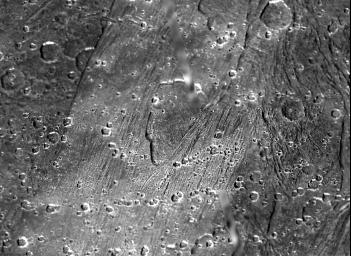
|
Caldera-like depression on Ganymede
- Click the image above for a larger view
- Full-Res JPEG (3777 x 2760) (1.2 MB)
- Full-Res TIFF (3777 x 2760) (7.1 MB)
Caption:
The shallow, scalloped depression in the center of this picture from NASA's Galileo spacecraft is a caldera-like feature 5 to 20 kilometers (3 to 12 miles) wide on Jupiter's largest moon, Ganymede.
Calderas are surface depressions formed by collapse above a subsurface concentration of molten material. Some shallow depressions in bright, smooth areas of Ganymede have some overall similarities to calderas on Earth and on Jupiter's moon Io.
On Ganymede, caldera-like depressions may serve as sources of bright, volcanic flows of liquid water and slush, an idea supported by a Ganymede photo obtained by Galileo during its seventh orbit and available at PIA01614 . In the more recent image here, from Galileo's 28th orbit, a tall scarp marks the western boundary of a caldera-like feature. The western scarp is aligned similarly to older tectonic grooves visible in the image, suggesting the feature has collapsed along older lines of weakness. The interior is mottled in appearance, yet smooth compared to most of Ganymede's bright terrain seen at high resolution. The eastern boundary of the caldera-like feature is cut by younger, grooved terrain. Small impact craters pepper the scene, but the lack of a raised rim argues against an impact origin for the caldera-like feature itself. Instead, water-rich icy lava may have once flowed out of it toward the east. If so, later tectonism could have erased any telltale evidence of volcanic flow fronts. Direct evidence for icy volcanism on Ganymede continues to be elusive.
North is to the top of the picture and the Sun illuminates the surface from the left. The image, centered at -24 degrees latitude and 318 degrees longitude, covers an area approximately 162 by 119 kilometers (101 by 74 miles). The resolution is 43 meters (141 feet) per picture element.
This image was produced by Brown University, Providence, R.I., http://www.planetary.brown.edu/ .
Background Info:
This image and other images and data received from Galileo are posted on the Galileo mission home page at http://www.jpl.nasa.gov/galileo . Background information and educational context for the images can be found at http://www.jpl.nasa.gov/galileo/sepo .
The Jet Propulsion Laboratory, a division of the California Institute of Technology in Pasadena, manages the Galileo mission for NASA's Office of Space Science, Washington, D.C.
Cataloging Keywords:
| Name | Value | Additional Values |
|---|---|---|
| Target | Ganymede | Io |
| System | Jupiter | |
| Target Type | Satellite | |
| Mission | Galileo | |
| Instrument Host | Galileo Orbiter | |
| Host Type | Orbiter | |
| Instrument | Solid-State Imaging (SSI) | |
| Detector | ||
| Extra Keywords | Crater, Grayscale, Impact, Volcano, Water | |
| Acquisition Date | ||
| Release Date | 2000-12-16 | |
| Date in Caption | ||
| Image Credit | NASA/JPL/Brown University | |
| Source | photojournal.jpl.nasa.gov/catalog/PIA02580 | |
| Identifier | PIA02580 | |
